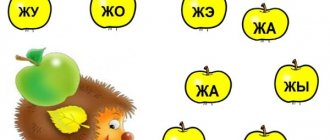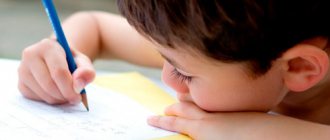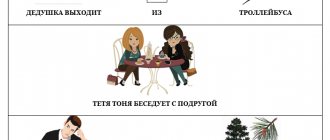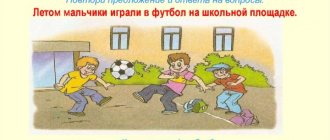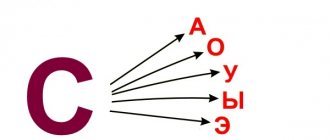"Collect the letter"
You can make such a simple puzzle yourself while working on the automation of any consonant. You need to cut out a large letter from a sheet of cardboard, cut it into separate elements and on each of them glue a picture with this consonant at the beginning of the word. In our case, this is the letter “c”. You can choose subject pictures as in our photo, or come up with your own.
In addition to developing the articulatory apparatus and pronouncing the sound being studied, children develop logical thinking and attentiveness, because they need to analyze the shape of the piece and find its place in the whole image of the letter, aligning the edges correctly.
Next stage of work
Automation of “s” in words begins immediately after its pronunciation in an intervocalic position and in combination with another consonant. Let's take a closer look at how work is carried out at this stage of automation.
Intervocalic position is when a consonant is surrounded by vowels on both sides. It is easier for a child to pronounce the following triple syllables: “asa”, “osu”, “isa”, “mustache”, “ose”, etc.
Then syllables with a combination of two, and then three consonants before a vowel are pronounced several times: “sma”, “sto”, “ske”, “sli”, etc. Triple consonants are more difficult for children, for example, such as: “stra” , “spro”, “skri”, etc.
Exercises for pronunciation of "s"
Children pronounce the isolated sound “s” first, repeating after the teacher or speech therapist. This stage should not be long. It is recommended to use onomatopoeic games only at the very beginning, when the baby has just learned to correctly articulate “s”. The emphasis in this case is on associations, for example, “repeat the bird’s whistle,” “tell me how the water makes noise,” “show me how the wind blows.” To help your child understand the difference between similar sounds, add associative exercises on “sh” and “s” to the game.
At the first stage, you can play the following games with your children:
- “Yula” - the speech therapist or mother spins the top, and while it is spinning, the child must repeat the learned sound “s”.
- “From bump to bump” - the baby is given a strip of paper with circles glued on. You can offer your child a small toy, such as a bunny, to help. He jumps from circle to circle, and the child repeats the sound “s” with each jump of the animal.
- “Talking pen” - the child is given a piece of paper on which long lines are drawn in dotted lines. The baby points them with his hand and pulls “c”.
- “Catch the ball” - the child throws a small ball or tennis ball from one hand to the other, while “catching” the “c”. You can play together. The mother throws the ball to the baby and pronounces the sound “s”. The child catches the toy and repeats “s” independently.
Speech therapy game “Help the baby elephant”
Let's look at another educational game for automating the sound “s” in words. In it, three buckets are first placed in front of the baby elephant. Each one has an object drawn on it. It must begin with a given consonant, or end, or have the sound being studied in the middle of the word.
For example:
- (Traffic light.
- Dog).
- Armchair.
The set includes a whole set of subject pictures depicted on the buckets. The child needs to distribute the cards into cells. You can make such a game not drawn on cardboard, but three-dimensional. Prepare three empty plastic buckets and a soft toy, such as an elephant or a bunny. On each of the buckets, stick a sample with a picture of the item. The child takes out pictures from the set one by one, names the object and determines the location of the “s” in its name.
You can separately do a task to automate “s” in the middle of a word, at the end or at the beginning. This game promotes the development of phonemic awareness, the ability to find “s” in words, and correctly determine their location.
Lesson notes “Sound B”
Goal: to develop the skill of pronunciation [B] in reverse syllables, at the end of words.
Tasks:
- consolidate the pronunciation of words in which the sound is at the beginning of the word, in straight syllables;
- use techniques of reflected repetition, independent naming of words from a picture;
- use tasks that direct the child to independently search for words containing [in];
- develop creative thinking;
- maintain interest in speech therapy classes.
Equipment: magnetic board or interactive whiteboard, paper figures with magnets.
Progress of the lesson.
I. Organizational moment.
— Guys, do you like fairy tales? — Would you like to be storytellers yourself?
The speech therapist puts on a fairy hat, picks up a magic wand, waves it:
- Krible! Crable! Boom! You are storytellers! Now let's get down to business.
II. Consolidation of what has been learned.
1. Articulation gymnastics.
- Once upon a time there were the sounds B and B'. What sounds are these? Vowels or consonants? Voiced or voiceless?
The sounds were friendly. They really loved delicious jam. Let's show how they ate it. Exercise “Delicious jam”.
2. Finger gymnastics.
They lived in a small town, in a small house. There is a house in a clearing, draw “House” with two hands, the roof of the house - the fingers of the left and right hands touch.
Well, the path to the house is closed. The right and left hands are turned with their palms facing themselves, the middle fingers rest against each other, the thumbs point upward (“gate”).
We open the gates, Palms parallel to each other.
We invite you to this house. Show “house” with two handles, the roof of the house - the fingers of the left and right hands touch.
3. Repeating the pronunciation of [B] in straight syllables.
Arrived at kindergarten (a sparrow figurine appears)…. Children: sparrow!
- Right! Sparrow. And he brought (an image of a scroll in a beak) a letter.
Let's see what is being said here. The brothers loved to travel. They went to the country of Imagination to their cousins [F and [F'] on a (picture) steam locomotive.
We got into the (picture) carriage and drove off. Whether long or short, they arrived at the (picture) station in the land of Imagination. They got out of the carriage, walked along the city streets, and brother [B'] lost brother [B].
Children name what is shown in the pictures. — Guys, the sound [B'] asks us for help. Helps you find your lost brother.
III. Automation of sounds in syllables.
What needs to be done to find him? We need to say it more often. Va-va-va-avav-ava-ava. Woo-woo-woo woo-woo-woo. You-you-you-you-you-you. Whoa, whoa, ovo, ovo, ovo.
IV. Automation of sounds in words.
Va-va-va my head was spinning. Woo-woo-woo I call my brother. I really don't understand anything. Ov-ov-ov no traces can be found. Ovy-ovy-ovy, both are ready to cry. “That’s how hard it was for the brothers.”
V. Physical exercise.
- Our magic bell will help us find the way, You just need to shake it a little first. And then don’t lose heart and follow the commands. Turn right (heads turn right)
And then to the left (head to the left). Directly in front of you is the Queen's castle (hands up). We walk together (walk in place), we need to hurry (run in place),
Our muscles will become stronger and more elastic. We open the gate (arms to the sides), Someone is waving at us (waving their arms). We were lost and found. We met and hugged (hug yourself with your arms).
VI. Game "Give me a word."
- Our fairy tale has come to a happy ending. The brothers found each other and decided to play a game. • One steam locomotive pulls and pulls onto the platform... a carriage.
• The little boy sat down in the living room on a huge... sofa.
• There is grass growing in the yard, There is... firewood on the grass.
• Very scary and fidgety. Boa constrictors crawl in the jungle.
• It is difficult for both tourists and tramps to overcome... ravines.
VII. Game “What sounds around us?”
- Look how many objects there are in this room, they all have names - these are words that sound. For example, I found the word “call”. Listen to how it sounds: call].
The speech therapist asks one of the children to repeat this word so that all sounds are heard very clearly. Then he asks him to find another word with the sound B, which is hidden in the room, and pronounce it so that the sounds are heard.
Next, he offers to repeat the word the child found to the next player, and so on.
During the game, the teacher monitors the clarity of the children’s pronunciation of words. If the child finds it difficult, you need to give him a hint. Words that a child can find in the group: cornflower, wolf, sleeve, head, bath, vase, cook, mitten, lapel, turn, crow, sparrow.
VIII. Summary of the lesson.
- What sound were we talking about today? - What is he like? -What good deed have we done?
When are automation measures necessary?
If the child pronounces [in] in isolation and articulates it correctly, then the production stage can be considered completed - now it is necessary to automate the sound. For this, some time must pass, a kind of sound “working out” must be completed. In some cases, children quickly incorporate the correct pronunciation into their speech, but this happens more often when the sound was introduced from scratch. But if it was necessary to correct incorrect sound pronunciation, to which the child has already become accustomed, then the speech therapist will have to take automation measures.
Difficulties in production [c]
Problems during sound production can be completely different, the main ones include the following:
- Weak innervation of the muscles of the speech apparatus. This is expressed in the fact that due to insufficient muscle tone of the organs of articulation (in particular the vocal cords, since they play the main role in the pronunciation of a given sound), the child simply cannot pronounce the sound. Without the participation of the voice, it turns out [f] instead of [v]. It will take time to develop connections so that the pronunciation is clear and correct.
- Malocclusion. This fact can also influence and give its complications in the staging [c], but this does not always happen.
- Lip defect. When pronouncing “B”, not only the teeth are involved, but also the lips. A short or drooping lower lip can make sound production difficult.
Game "Count the objects"
To automate the “s” at the beginning of a word, you can offer children an interesting and educational game. The card shows objects whose names begin with the learned syllables:
- Su - bag.
- Su - chest.
- So - juice.
- Sa - sandals.
- So - catfish.
- So - sable.
The child points to an object with a pointer or finger and names it, then looks for the same one further down the row, and when he finds it, again says its name out loud. Thus, as the game progresses, the child several times calls the word the teacher needs, which begins with the learned syllable. This game develops not only speech, but also attention. The child learns to find the same ones from a large number of pictures, without missing a single one.
Pure talk
After this stage, automation of “s” in words is not yet carried out. Work is underway to combine it into syllables.
According to the method, fricative consonants such as “s” are first learned in simple syllables, for example, “so”, “se”, etc. Then the work is carried out with reverse syllables, when the vowel comes first, followed by the consonant , for example, “as”, “us”.
Pure sayings are widely used in pedagogy, when children pronounce separate syllables after the teacher, and then sentences with this syllable at the end.
At first, the child simply repeats all this after the speech therapist. Next, you can offer several exercises to develop phonemic awareness and attentiveness, since children often do not hear and do not understand which sound needs to be inserted into a word. Let's list some of them:
- “Continue the word.” The teacher says the beginning of the word, and the child finishes its last syllable. To make the task easier, you can offer your child subject or story pictures. The following words will do:
-fox;
-sausage;
-bu – sy;
-hair;
-watch.
- “Switch places.” The adult offers to determine the place of “s” in the syllable: at the beginning or at the end. When the child has correctly indicated its location, the teacher asks to swap the vowel and consonant, for example, it was “sa”, but needs to be converted to “as”. It is advisable to carry out such an exercise to develop the skills of phonemic analysis and synthesis.
Didactic game “Elephant in the Circus”
The child is given a picture of a circus elephant juggling balls. Each one has a picture of an object whose name includes “c”. The child examines and speaks out loud what the elephant is juggling. The game can be varied in every possible way.
To automate the “s” in words, you can select options with different pronunciation difficulties. It is interesting to place three circles on top and give the child the task of finding from a variety of cards objects in the name of which “s” is at the beginning of the word, in the middle and at the end. Next you need to arrange all the pictures into the correct piles.

